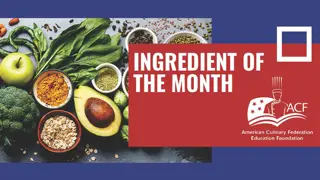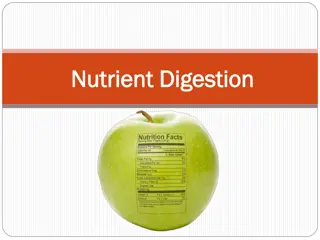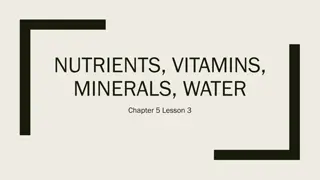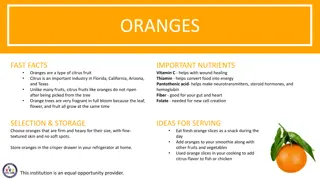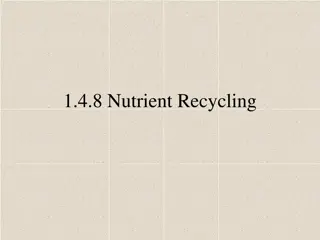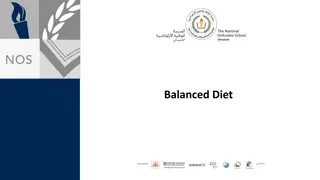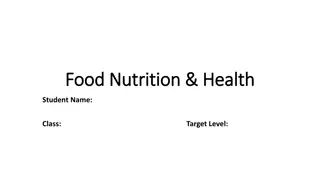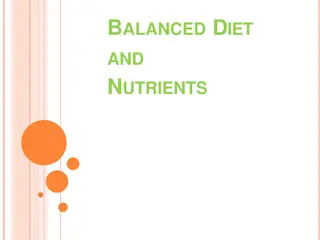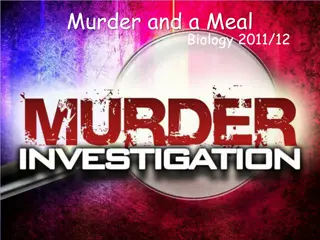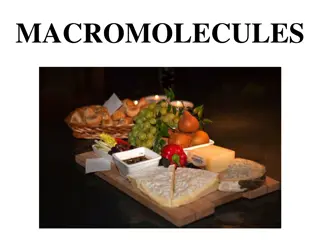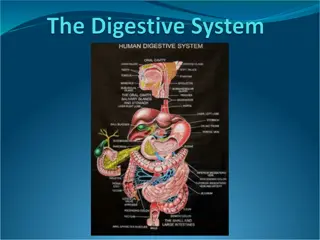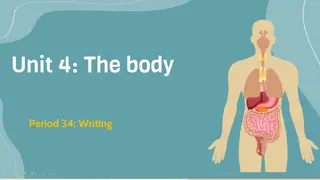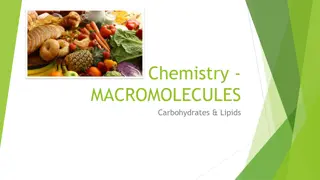Understanding Macromolecules and Essential Nutrients for Overall Well-being
Learn about the main types of macromolecules - Carbohydrates, Lipids, Proteins, and Nucleic Acids - and how they contribute to our health. Explore the importance of essential nutrients available in everyday foods for growth and overall well-being, including carbohydrates, fats, proteins, vitamins, and minerals. Discover the role of monomers and polymers in macromolecules and the different types of sugars in carbohydrates.
Download Presentation

Please find below an Image/Link to download the presentation.
The content on the website is provided AS IS for your information and personal use only. It may not be sold, licensed, or shared on other websites without obtaining consent from the author. Download presentation by click this link. If you encounter any issues during the download, it is possible that the publisher has removed the file from their server.
E N D
Presentation Transcript
08 -31- 11 WARM-UP: Agenda 1) In the cleaning pennies lab, which solution cleaned the best? 1) Warm-Up (5 min) Ketchup Vinegar 2)Measurement WS (20 min) 3)Biomolecules Notes (30 mins) 2) What is one thing we could change in the cleaning pennies experiment? Type of solution, type of coin, temp. of solution etc. HOMEWORK DUE: Contracts & Binder
When you see the Copy the notes!
NUTRITION: NUTRITION: Where do we get our nutrients? Macromolecules, Vitamins and Minerals
Our body needs essential nutrients for growth, health and overall well being. We cannot be sedentary and deny our body these essentials and be healthy. You need to be aware of the vital nutrients, vitamins and minerals available in everyday foods.
What are the four main types of macromolecules? 1. Carbohydrates 2. Lipids 3. Proteins 4. Nucleic Acids
Macromolecules Concept Map Section 38-1 Nutrients include Carbohydrates Fats Proteins Vitamins Minerals include are made of are made using include include Amino acids Simple Complex Calcium Iron such as such as Fatty Acids Glycerol Water- soluble Sugars Starches Fat-soluble
Macromolecules Macromolecules = Large organic molecules Monomers (small molecules) Polymers (large molecules)
Macromolecules Macromolecules Carbohydrates (sugars & starch) Lipids(fats) Proteins Nucleic Acids (DNA & RNA)
Carbohydrates Monosaccharides (simple sugars) i.e. C6H12O6 -glucose Disaccharides (double sugars) i.e. sucrose table sugar Polysaccharides (complex sugars) starch, cellulose, and glycogen
Carbohydrate Functions Quick energy foods. Storage: Plants starch Animals glycogen
Lipids (FATS) Molecules that store the most energy for living systems Made of C, H, O Insoluble in water
Types of Lipids Types of Lipids Triglyceride 3 Fatty Acids bonded to a Glycerol Steroids cholesterol, hormones Phospholipids Unsaturated: Double bonds between some of the carbons Saturated: No double bonds between the carbons
Lipid Functions Lipid Functions Important in cell membrane High energy food Protects vital organs Insulates the body Stores food for later use
Protein Function Protein Function Most Abundant-50% of Dry Wt Essential to Life Build structure Movement: Makes up muscle tissue (ex. actin and myosin). Transport: Carries oxygen in an organism (ex. hemoglobin). Immunity: Helps fight off foreign invaders (ex. antibodies). Enzymes: Speed up chemical reactions (ex. amylase and trypsin).
Protein (Structure) Protein (Structure) H, O, N, C (sometimes S) Monomer amino acids 20 different Each amino acid contains an amino group (NH2) Carboxyl group (COOH) Unique R group Polymer: Polypeptide
Nucleic Acids Monomer - nucleotides (sugar, phosphate and nitrogen base) DNA (Deoxyribonucleic acid) RNA (Ribonucleic acid)
Carbohydrates 1. Main source of energy for the body 2. 1gram = 4 Calories 3. Monosaccarides (Simple carbs) found in fruits, honey, and sugar cane 4. Polysaccarides (Complex carbs) found in starches such as grains & potatoes 5. Polysaccarides are digested into monosaccarides.
Fats 1. Fat is broken down into glycerol and fatty acids. 1 gram = 9 Calories 2. Essential fatty acids found in vegetable oils 3. Help body absorb certain vitamins 4. Used to produce 1. Cell membranes 2. Myelin sheaths 3. Hormones
Proteins 1. Supply raw materials for growth and repair 2. The building block of protein are amino acids. 3. 1gram = 4 Calories 4. Enzymes 5. Regulatory & transport functions 1. Insulin 2. hemoglobin 6. Body only makes 12 AA 1. Must include the other 8 AA from your diet
Nucleic Acids Obtain nitrogen from protein sources. Body makes and recycles the necessary components to produce nitrogenous bases that will form: DNA & RNA
Vitamins 1. Organic molecules that help regulate body processes 2. Often work with enzymes 3. Most must be obtained from food 4. Vitamin deficiencies and overdose have serious consequences 5. There are 2 types of Vitamins: 1. Fat Soluble 2. Water Soluble
Types of Vitamins Vitamin Sources Function Yellow, orange, and dark green vegetables; dairy products Important for growth of skin cells; important for night vision A (retinol) Fish oils, eggs; made by skin when exposed to sunlight; added to dairy products Promotes bone growth; increases calcium and phosphorus absorption D (calciferol) Green leafy vegetables, seeds, vegetable oils Antioxidant; prevents cellular damage E (tocopherol) Green leafy vegetables; made by bacteria that live in human intestine Needed for normal blood clotting K Whole grains, pork, legumes, milk Normal metabolism of carbohydrates B1 (thiamine) Dairy products, meats, vegetables, whole-grain cereal Normal growth; part of electron transport chain; energy metabolism B2 (riboflavin)
Types of Vitamins Vitamin Sources Function Liver, milk, whole grains, nuts, meats, legumes Important in energy metabolism Niacin Whole grains, meats, vegetables Important for amino acid metabolism B6 (pyridoxine) Meats, dairy, whole grains Needed for energy metabolism Pantothenic acid Legumes, nuts, green leafy vegetables, oranges, broccoli, peas, fortified bread and cereal Coenzyme involved in nucleic acid metabolism; prevents neural-tube defects in developing fetuses Folic acid Meats, eggs, dairy products, enriched cereals Coenzyme in nucleic acid metabolism; maturation of red blood cells B12 (cyanocobalamin)
Types of Vitamins Vitamin Sources Function Citrus fruits, tomatoes, red or green peppers, broccoli, cabbage, strawberries Maintenance of cartilage and bone; antioxidant; improves iron absorption; important for healthy gums, tissue repair, and wound healing C (ascorbic acid) Legumes, vegetables, meat Coenzyme in synthesis of fat; glycogen formation; amino acid metabolism Biotin Egg yolk, liver, grains, legumes Required for phospholipids and neurotransmitters Choline
Minerals 1. Inorganic nutrients 2. Needed in small amounts 3. By eating a variety of foods you can meet your daily requirements
Types of Minerals Mineral Sources Function Diary products; salmon; sardines; kale; tofu; collard greens; legumes Bone and tooth formation; blood clotting; nerve and muscle function Calcium Dairy products; meats; poultry; grains Bone and tooth formation; acid-base balance Phosphorus Meats; dairy products; many fruits and vegetables; grains Acid-base balance; body water balance; nerve function Potassium Table salt; processed foods Acid-base balance; formation of gastric juice Chlorine Table salt; processed foods Acid-base balance; body water balance; nerve function Sodium Whole grains; green leafy vegetables Activation of enzymes in protein synthesis Magnesium Meats; eggs; legumes; whole grains; green leafy vegetables; dried fruit Component of hemoglobin and of electron carriers used in energy metabolism Iron Fluoridated drinking water; tea; seafood Maintenance of tooth structure; maintenance of bone structure Fluorine Seafood; dairy products; iodized salt Component of thyroid hormones Iodine Meats; seafood; grains Component of certain digestive enzymes Zinc
Food Guide Pyramid Section 38-1 Fats, Oils, and Sweets (use sparingly) Soft drinks, candy, ice cream, mayonnaise, and other foods in this group have relatively few valuable nutrients. Milk, Yogurt, and Cheese Group (2-3 Servings) Milk and other dairy products are rich in proteins, carbohydrates, vitamins, and minerals. Meat, Poultry, Fish, Dry Beans, Eggs, and Nut Group (2-3 servings) These foods are high in protein. They also supply vitamins and minerals. Vegetable Group (3-5 servings) Vegetables are a low-fat source of carbohydrates, fiber, vitamins, and minerals. Fruit Group (2-4 servings) Fruits are good sources of carbohydrates, fiber, vitamins and water. Bread, Cereal, Rice and Pasta Group (6-11 servings) The foods at the base of the pyramid are rich in complex carbohydrates and also provide proteins, fiber, vitamins, and some minerals. Fats Sugars
Food labels Activity Work on numbers 14 and 15 on second page until the whole class is done with the first part of the worksheet. Then we will discuss numbers 10-13
Total fats DORITO s 8 grams Klondike 1.5 grams Trail mix 4 grams Sour patch 0 grams
DUE TODAY: Bimolecules Notes (KEEP) Every act of creation is first an act of destruction. Pablo Picasso DUE NEXT CLASS: SAFETY CONTRACT & Syllabus contract Binder/spiral/KLEENEX



